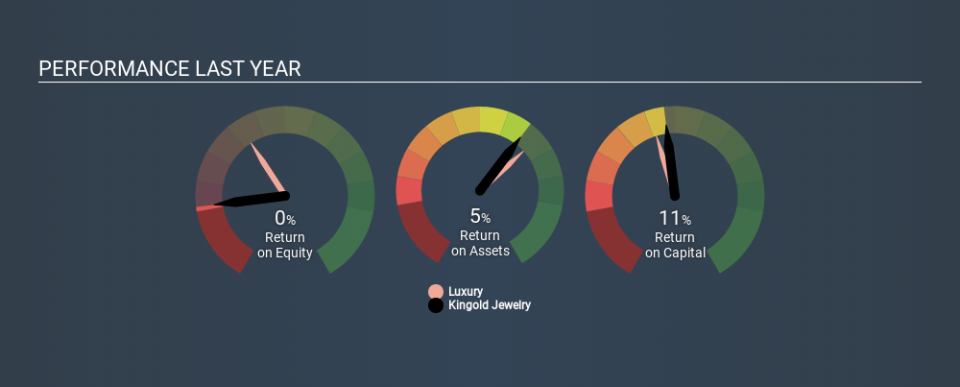Is Kingold Jewelry, Inc. (NASDAQ:KGJI) Better Than Average At Deploying Capital?

Today we'll look at Kingold Jewelry, Inc. (NASDAQ:KGJI) and reflect on its potential as an investment. To be precise, we'll consider its Return On Capital Employed (ROCE), as that will inform our view of the quality of the business.
First of all, we'll work out how to calculate ROCE. Second, we'll look at its ROCE compared to similar companies. Last but not least, we'll look at what impact its current liabilities have on its ROCE.
Understanding Return On Capital Employed (ROCE)
ROCE is a metric for evaluating how much pre-tax income (in percentage terms) a company earns on the capital invested in its business. Generally speaking a higher ROCE is better. Ultimately, it is a useful but imperfect metric. Author Edwin Whiting says to be careful when comparing the ROCE of different businesses, since 'No two businesses are exactly alike.
So, How Do We Calculate ROCE?
Analysts use this formula to calculate return on capital employed:
Return on Capital Employed = Earnings Before Interest and Tax (EBIT) ÷ (Total Assets - Current Liabilities)
Or for Kingold Jewelry:
0.11 = US$199m ÷ (US$3.3b - US$1.5b) (Based on the trailing twelve months to September 2019.)
So, Kingold Jewelry has an ROCE of 11%.
Check out our latest analysis for Kingold Jewelry
Is Kingold Jewelry's ROCE Good?
When making comparisons between similar businesses, investors may find ROCE useful. It appears that Kingold Jewelry's ROCE is fairly close to the Luxury industry average of 11%. Independently of how Kingold Jewelry compares to its industry, its ROCE in absolute terms appears decent, and the company may be worthy of closer investigation.
The image below shows how Kingold Jewelry's ROCE compares to its industry, and you can click it to see more detail on its past growth.
It is important to remember that ROCE shows past performance, and is not necessarily predictive. ROCE can be deceptive for cyclical businesses, as returns can look incredible in boom times, and terribly low in downturns. ROCE is only a point-in-time measure. If Kingold Jewelry is cyclical, it could make sense to check out this free graph of past earnings, revenue and cash flow.
Do Kingold Jewelry's Current Liabilities Skew Its ROCE?
Current liabilities are short term bills and invoices that need to be paid in 12 months or less. Due to the way the ROCE equation works, having large bills due in the near term can make it look as though a company has less capital employed, and thus a higher ROCE than usual. To counteract this, we check if a company has high current liabilities, relative to its total assets.
Kingold Jewelry has total liabilities of US$1.5b and total assets of US$3.3b. Therefore its current liabilities are equivalent to approximately 46% of its total assets. With this level of current liabilities, Kingold Jewelry's ROCE is boosted somewhat.
The Bottom Line On Kingold Jewelry's ROCE
With a decent ROCE, the company could be interesting, but remember that the level of current liabilities make the ROCE look better. Kingold Jewelry shapes up well under this analysis, but it is far from the only business delivering excellent numbers . You might also want to check this free collection of companies delivering excellent earnings growth.
If you like to buy stocks alongside management, then you might just love this free list of companies. (Hint: insiders have been buying them).
If you spot an error that warrants correction, please contact the editor at editorial-team@simplywallst.com. This article by Simply Wall St is general in nature. It does not constitute a recommendation to buy or sell any stock, and does not take account of your objectives, or your financial situation. Simply Wall St has no position in the stocks mentioned.
We aim to bring you long-term focused research analysis driven by fundamental data. Note that our analysis may not factor in the latest price-sensitive company announcements or qualitative material. Thank you for reading.


